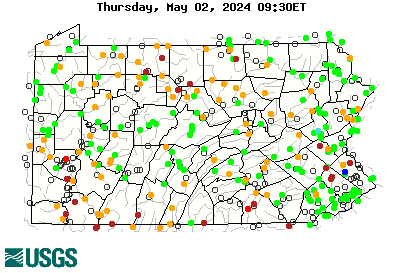You are using an out of date browser. It may not display this or other websites correctly.
You should upgrade or use an alternative browser.
You should upgrade or use an alternative browser.
Indicator
- Thread starter OlyphantLacky
- Start date
"That which doesn't kill me makes me stronger."
But Jack, if it kills you than you're....................dead.
Back to the original topic. Indicators have their time and place when I fish. A few different ways I rig not mentioned above are for one, putting a shot above the fly 4 – 8” and putting another shot spaced evenly between the fly and the indicator. This rig controls the inevitable belly between the indicator and the fly. It makes the presentation more vertical. In faster, deeper water you can space several shot between the fly and indicator.
Another rig I use, with or without and indicator is putting the shot on the point (end) of the tippet. I use a double overhand knot on the end of the tippet to stop the shot from sliding off. I tie one or two flies in between. The fly closest to the shot is usually tied 12” above the shot. The shot bounces along the bottom and the fly drifts maybe 4- 8” above the bottom depending on the angle. I use this rig in places where a keep getting hung up on the bottom with my flies. With this rig, when you do hang up, most of the time you can pull the shot free. With the right amount of weight, the shot should tick along the bottom. Another added benefit of the rig is that the fish see the fly before the shot. Also, with a conventional rig the weight is between the fly and your leader, making strike detection tough, when the fish hits with this rig, there is no weight between the fish and your leader, making strike detection / feeling the strike easier. In addition, it casts well without tangling since the weight is on the point. This is usually my deep / fast water rig, I generally don’t use an indicator with it but you can if it helps. I watch the line and fish more by feel – like Czech numphiing or in the old bait fishin’ days.
Short of having a fly fishing caddy to shag you're snags, this is the best rig if found to dredge the bottom in deeper fast water. Give it a try.
But Jack, if it kills you than you're....................dead.
Back to the original topic. Indicators have their time and place when I fish. A few different ways I rig not mentioned above are for one, putting a shot above the fly 4 – 8” and putting another shot spaced evenly between the fly and the indicator. This rig controls the inevitable belly between the indicator and the fly. It makes the presentation more vertical. In faster, deeper water you can space several shot between the fly and indicator.
Another rig I use, with or without and indicator is putting the shot on the point (end) of the tippet. I use a double overhand knot on the end of the tippet to stop the shot from sliding off. I tie one or two flies in between. The fly closest to the shot is usually tied 12” above the shot. The shot bounces along the bottom and the fly drifts maybe 4- 8” above the bottom depending on the angle. I use this rig in places where a keep getting hung up on the bottom with my flies. With this rig, when you do hang up, most of the time you can pull the shot free. With the right amount of weight, the shot should tick along the bottom. Another added benefit of the rig is that the fish see the fly before the shot. Also, with a conventional rig the weight is between the fly and your leader, making strike detection tough, when the fish hits with this rig, there is no weight between the fish and your leader, making strike detection / feeling the strike easier. In addition, it casts well without tangling since the weight is on the point. This is usually my deep / fast water rig, I generally don’t use an indicator with it but you can if it helps. I watch the line and fish more by feel – like Czech numphiing or in the old bait fishin’ days.
Short of having a fly fishing caddy to shag you're snags, this is the best rig if found to dredge the bottom in deeper fast water. Give it a try.
Wulff Man
I’m not a big fan of tying 4-5” droppers off the tippet, they tangle too much for me, and it adds to the amount of knots you must tie. I simply tie on a long tippet – long enough for 2 flies and the point shot. For example I’ll peel off 60” of tippet – tie it to the leader – tie in my 1st fly 30” from the tippet knot and leave a long tag end – tie in the 2nd fly 18 “ below the 1st on the tag - and put my shot 12” away on the point. Of course the length changes according to the depth and speed of the water. Also, you can tie the flies closer together to get them both deeper, or tie the upper fly higher to probe the middle depth of the stream. I don’t like the flies too close, you tend to snag too many fish with the second fly when you get a hookup.
The great thing about rigging this way besides less tangling, is that I do not have to tie any extra knots – a tippet to leader knot – knot on the 1st fly – knot on the 2nd fly - put on your shot and you’re read to go. Some would tie the flies to the bend of the hook – I find a get more hits and better hookups with the flies attached at the eye. Maybe the hook is less obstructed – maybe the fly drifts more naturally – only the trout know that answer. If you want to change either fly, you can cut it off and retie directly to the eye – no need to change the entire rig.
I’ve messed with this rig for some time and it works for me in some tough situations. Actually this is my old carp and sucker fishin rig I used when I was a kid.............go figure.
Time to go Fishin’…………..
I’m not a big fan of tying 4-5” droppers off the tippet, they tangle too much for me, and it adds to the amount of knots you must tie. I simply tie on a long tippet – long enough for 2 flies and the point shot. For example I’ll peel off 60” of tippet – tie it to the leader – tie in my 1st fly 30” from the tippet knot and leave a long tag end – tie in the 2nd fly 18 “ below the 1st on the tag - and put my shot 12” away on the point. Of course the length changes according to the depth and speed of the water. Also, you can tie the flies closer together to get them both deeper, or tie the upper fly higher to probe the middle depth of the stream. I don’t like the flies too close, you tend to snag too many fish with the second fly when you get a hookup.
The great thing about rigging this way besides less tangling, is that I do not have to tie any extra knots – a tippet to leader knot – knot on the 1st fly – knot on the 2nd fly - put on your shot and you’re read to go. Some would tie the flies to the bend of the hook – I find a get more hits and better hookups with the flies attached at the eye. Maybe the hook is less obstructed – maybe the fly drifts more naturally – only the trout know that answer. If you want to change either fly, you can cut it off and retie directly to the eye – no need to change the entire rig.
I’ve messed with this rig for some time and it works for me in some tough situations. Actually this is my old carp and sucker fishin rig I used when I was a kid.............go figure.
Time to go Fishin’…………..
Latest posts
-
-
-
-
PFBC Meets Tomorrow Regarding Stocking Over Class A Populations
- Latest: The Rodfather




